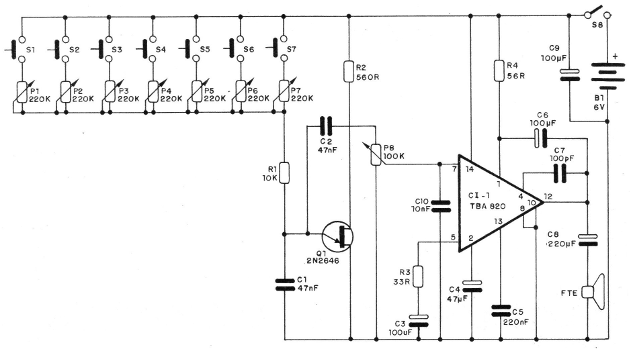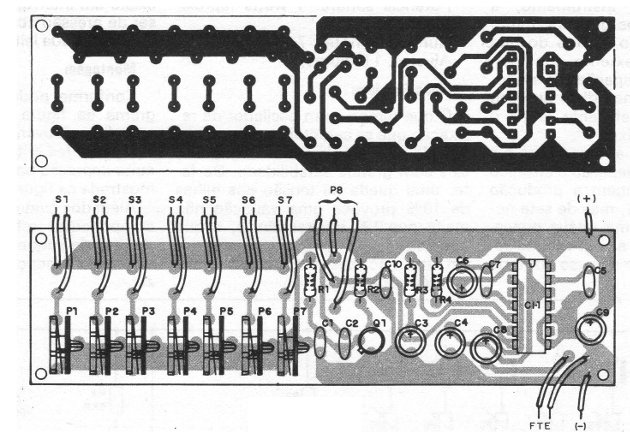To tune an instrument, most musicians rely more on their own ear than any external device.
Although some use wind tuning forks, we can not always say that their use is pleasant or efficient, since the sound produced is low.
What we propose to the musicians is the assembly of an electronic tuning fork which has the advantage not only of producing a note but of any seven notes of a previously selected octave, and with sufficient volume to facilitate its use throughout an ensemble.
Powered by batteries and having its own amplifier, this tuning fork can be used anywhere, and once calibrated will have excellent accuracy.
The characteristics of this tuning fork are as follows:
Characteristics:
Supply voltage: 6 V (4 batteries).
Sound power: 1 watt (approximately).
Number of notes: 7.
Settings: 1 (volume).
How it works
What we have is a relaxation oscillator that is characterized by the coverage of a wide range of frequencies with great stability. In fact, a voltage drop in the 10% battery causes a variation of not more than 1% in the frequency, which means that once the circuit has been adjusted, we no longer need to tamper with its controls.
The capacitor C1 determines, together with each trimpot, the frequency of the chosen note. The (fa) 440 kHz of the 5th octave is usually the most used note in the tuning, but other octaves can be chosen with the simple exchange of C1
For this, it will be enough to double the value to every octave that we want to descend, or reduce by half for each octave that we want to raise.
The signal produced by this oscillator is applied to an integrated amplifier that provides good power in a common speaker. At the input of this amplifier we added a volume control for greater ease of use.
To activate each note there is a switch that can be both pressure and simple, depending on each player of your choice.
Assembly
As can be seen from the diagram in figure 1, it is a relatively simple apparatus with no critical components.

The printed circuit board for this assembly is shown in figure 2.

In addition to normal care with polarity components, use of sockets etc., we have some additional recommendations to make.
One of them refers to the integrated one that can be found with several pinouts. We chose the type "S" that has DIL pinion, with pins aligned.
The circuit can be assembled with more modern integrated as the TDA7052.
If the reader opts for a version that has alternate pins that are also available on the market, you should change the design of the card.
Another recommendation is referring to the keyboard. In the assembly of the prototype we use keys of the type used in microcomputers that allow a much more comfortable handling and an excellent appearance for the device.
Finally, it should be noted that the values of C1 can be changed to modify the tuning fork, covering other octaves that are more appropriate to the instrument used.
Increasing C1 will have lower octave scores.
Another important point is that of snoring through the amplifier input circuit.
The TBA820 is very sensitive, so if the mount uses a source, or unshielded case, snoring (and even radio stations) may be picked up from the input.
Thus, there are two possibilities for assembly: use a grounded metal box (negative of the source connected to the box), or shielded cables in the volume control (from C2 to P8 and the cursor from P8 to pin 7 of the integrated).
The screen of this shielded cable must be connected to the source negative.
Test and use
For the test, simply place the batteries in the holder and connect S8. By pressing any of the switches (S1 to S7), open the volume at P8. If there is no sound, adjust the corresponding trimpot to the tight switch until this occurs.
Check the operation of all switches. With this, with the help of a tuned instrument, adjust each trimpot to a note of the desired octave.
Then just close the device in the box and use it.
Cl-1 - TBA820S - integrated circuit
Q1 - 2N2646 - unijunction transistor
P1 to P7 - 220 k trimpots (see text)
P8 - 100 k potentiometer
FTE - 8 ohm speaker x10 cm
B1 - 6 V - 4 small or medium size batteries
S1 to S7 – push butttons
S8 – On-Off switch (ganged to P8)
C1, C2 - 47 nF (473) - Ceramic or polyester capacitors
C3, C6, C9 - 100 uF - electrolytic capacitors
C4 - 47 uF - electrolytic capacitor
C5 - 220 nF (224) - ceramic or polyester capacitor
C7 - 100 pF - ceramic capacitor
C8 - 220 uF - electrolytic capacitor
C10 -10 nF - ceramic capacitor
Miscellaneous: mounting box, printed circuit board, support for 4 small or medium batteries, wires, soldering etc.



